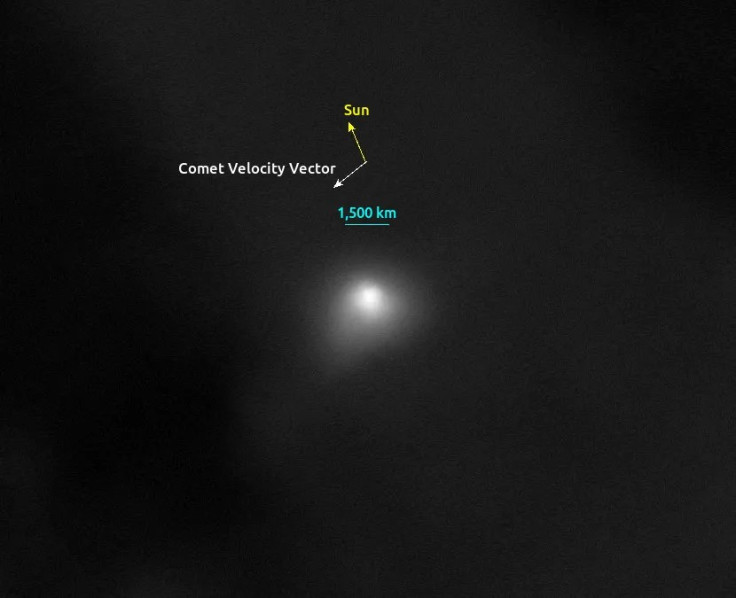3I/ATLAS: Structural Features Never Documented In Any Known Celestial Object
The interstellar comet 3I/ATLAS challenges physics with a missing dust tail, a forward anti-tail, and strange composition.

What if everything astronomers thought they knew about comets was wrong? On November 22, 2025, an amateur astronomer in Aguadilla, Puerto Rico, Efraín Morales Rivera, did more than just take a picture; he captured evidence that an interstellar visitor is rewriting the rulebook of celestial mechanics.
The object, known as 3I/ATLAS, is only the third confirmed interstellar visitor to our solar system—discovered by the NASA-funded ATLAS survey telescope in Chile on July 1, 2025.
Unlike its predecessors, 1I/'Oumuamua in 2017 and 2I/Borisov in 2019, the behaviour and morphology of this comet, especially after it passed perihelion at 1.36 AU from the Sun on October 29, challenge fundamental assumptions about cometary physics, structural integrity, and outgassing dynamics.
Rivera's images, retrieved using a standard 305mm telescope, initially depicted a plain, unremarkable green comet without a visible tail.

However, subsequent enhanced processing exposed a reality far more perplexing: bilateral gas emissions extending from a compact central core, a prominent forward-facing anti-tail stretching toward the Sun, and the complete absence of the massive, expected dust trail that should stream behind any comet following perihelion.
This unprecedented combination of characteristics has prompted intensive international scrutiny of the mysterious object.

Unprecedented Morphology of 3I/ATLAS: The Reverse-Flow Anti-Tail
The structural anomalies observed in the November 22 images are complex. At the core, the object displays green and blue gas emissions distributed asymmetrically on either side of a bright central nucleus, contrasting sharply with the diffuse spherical coma typical of active solar system comets. Even more astonishing is the prominent, forward-facing anti-tail.
When the image brightness is inverted to enhance faint structures, the anti-tail becomes unmistakable: a distinct extension of material projecting in the direction of the object's motion, effectively pointing toward the Sun.
This phenomenon has persisted since the Hubble Space Telescope first documented it in July 2025, long before the object reached perihelion. Harvard astronomer Avi Loeb has noted that such a sunward-facing structure could theoretically function as a protective shield, clearing debris from the flight path through mechanisms analogous to electromagnetic deflection systems.
Furthermore, the compact round core visible in Rivera's telescope images raises additional questions. At current resolution from ground-based instruments, the nucleus appears spherical, rather than displaying the irregular, potato-like shapes typical of comet nuclei.
NASA has not released unprocessed high-resolution imagery from space-based platforms that could resolve surface features and confirm or refute the apparent sphericity. The bilateral gas emissions visible in the enhanced images suggest active venting from specific, perhaps highly directional, locations on the nucleus surface rather than uniform sublimation.
The green colour indicates diatomic carbon molecules produced by the breakdown of organic compounds under solar radiation, while subtle blue tints may represent ionized carbon monoxide or other molecular species.
The asymmetric distribution of these gases does not match the expected pattern for a rotating body uniformly heated by the Sun, suggesting either an irregular surface topography with specific active regions or internal thermal processes at play within the 3I/ATLAS core.

The Missing Dust Trail: Challenging Cometary Physics with 3I/ATLAS
What makes the Puerto Rico images particularly significant is not what they show, but what they utterly lack.
Standard cometary physics predicts that an object losing more than thirteen percent of its mass during perihelion passage—as 3I/ATLAS has, according to JPL's non-gravitational acceleration data—should produce a massive, visually prominent tail of dust and ionized gas pushed away from the Sun by radiation pressure and solar wind.
The expected tail length for an object at this distance and mass-loss rate would extend hundreds of thousands of kilometres.
Yet the November 22 images show no such structure. The compact core remains essentially unchanged from its pre-perihelion appearance, with only the persistent anti-tail and subtle bilateral gas emissions visible.
The non-gravitational acceleration itself was only a minor deviation, measuring approximately $5 times 10^{-7}$ au per day squared, which is nonetheless enough to suggest a massive loss of material or an unknown propulsion force.
This absence of post-perihelion tail development has become one of the most discussed anomalies among researchers tracking the object.
While images from other observatories between November 8 and November 19 have shown complex tail structures developing—multiple thin jets extending in various directions, some spanning more than 2.85 million kilometres—these structures appear fundamentally different from the broad, diffuse dust tails characteristic of solar system comets.
The jets are narrow, collimated, and display geometric patterns that suggest either highly directional outgassing from discrete surface vents or mechanisms not yet understood.
Adding to the mystery are compositional anomalies. Spectroscopic analysis by the James Webb Space Telescope in late August detected an unusual nickel-to-cyanide ratio in the object's gas emissions—orders of magnitude higher than any known natural comet.
The object brightened faster than predicted models suggested possible for a natural icy body, and showed a blue colour shift near perihelion inconsistent with simple reflective properties.
This blue shift has been theorised to be the result of a high concentration of molecular ions like $CO^{+}$ and $H_{2}O^{+}$ which are typically not dominant in natural cometary comas.
Trajectory and Technology: The Scientific Scrutiny of 3I/ATLAS
The object's unusual behaviour has triggered U.S. planetary defence co-ordination protocols, though officials have confirmed that 3I/ATLAS poses zero collision threat to Earth. Its closest approach to our planet will occur on December 19, 2025, at a safe distance of 1.8 AU—roughly 270 million kilometres.
What concerns researchers is not the risk of impact, but the scientific implications of an object that appears to violate established models of cometary structure and behaviour, as detailed in the article: Unprecedented Morphology Challenges Everything We Know About Comets.
Following perihelion, 3I/ATLAS passed within 97 million kilometres of Venus on November 3 and continues its outbound trajectory toward a close approach to Jupiter on March 16, 2026.
The Jupiter encounter distance of 53.4 million kilometres is remarkably close to Jupiter's Hill sphere radius—the gravitational boundary within which objects become bound to the planet rather than the Sun.
This geometric coincidence has prompted speculation about whether the object's trajectory has been shaped by non-gravitational forces to target specific waypoints in the solar system.
Furthermore, its trajectory through the solar system is aligned within five degrees of the ecliptic plane despite its retrograde orbit and interstellar origin—a geometric coincidence that occurs in less than one in five hundred randomly arriving objects.
The low inclination of its retrograde orbit (around $175^{circ}$ relative to the ecliptic) is statistically rare for an interstellar object and is a key factor supporting the possibility of an intentional trajectory.
Future spectroscopic observations scheduled for December as 3I/ATLAS approaches Earth will attempt to measure the velocity and composition of the anti-tail material. If the outflow velocities exceed several kilometres per second—consistent with high-thrust propulsion rather than passive gas expansion—the natural comet interpretation will face significant challenges.

Conversely, if the velocities and composition match predictions for large-grain dust ejection, the unusual morphology may simply represent a previously unobserved but natural process occurring in interstellar comets with compositions radically different from solar system objects.
The predicted Jupiter flyby distance of $53.445 pm 0.06$ million kilometres is within the Hill sphere radius, a proximity calculated to have a likelihood of less than a millionth of a chance, factoring in both the orbital alignment and the timing.
The Rivera images from November 22 document a moment when this visitor from another star system displayed features that no textbook predicted and no previous observation recorded. They represent the work of dedicated amateur astronomers whose contributions to understanding our universe remain essential despite the sophistication of space-based platforms.
As Dr. Avi Loeb notes in his analysis with Dr. Eric Keto, while potential natural mechanisms for anti-tail formation exist through anisotropic ice sublimation, 'if upcoming observations confirm outflow velocities exceeding several kilometres per second, alternative explanations including technological origins would require serious consideration'. The object's close approach provides a final opportunity for detailed Earth-based observation before it exits the inner solar system permanently.
The enigma of 3I/ATLAS proves that the cosmos still presents phenomena that demand we question, verify, and expand our understanding of what is possible, challenging everything we thought we knew about cometary science and interstellar visitors. With its final close approach to Earth scheduled for December 19, 2025, a crucial window for observation is rapidly closing.
© Copyright IBTimes 2025. All rights reserved.




















